预测雷暴旋转的基础机器学习:分类 - 决策树超参数试验
本文翻译自 AMS 机器学习 Python 教程,并有部分修改。
Lagerquist, R., and D.J. Gagne II, 2019: “Basic machine learning for predicting thunderstorm rotation: Python tutorial”. https://github.com/djgagne/ams-ml-python-course/blob/master/module_2/ML_Short_Course_Module_2_Basic.ipynb.
本文接上一篇文章《预测雷暴旋转的基础机器学习:分类 - 决策树》,介绍如何通过超参数试验确定决策树的最小样本量。
简介
两个超参数(以及其他)控制决策树的深度:
- 每个分支节点的最小样本量 (N_{b}^{min})
- 每个叶节点的最小样本量 (N_{l}^{min})
如果将这些值设置为 1,则树可能会变得很深,从而增加其过拟合的能力。
您可以用另一种方式思考:如果每个叶节点上只有一个示例,则所有预测都将仅基于一个示例,并且可能无法很好地推广到新数据。
相反,如果将 N_{b}^{min} 和 N_{l}^{min} 设置得过高,则树将变得不够深,从而导致树欠拟合。
例如,假设有 1000 个训练样本并将 N_{l}^{min} 设置为 1000。 这将只允许一个分支节点(根节点)。 根节点的两个子节点都具有 <1000 个示例。 因此,预测将仅基于一个问题。
回顾超参数试验的四个步骤
- 选择要尝试的值
我们尝试
Nminb∈{2,5,10,20,30,40,50,100,200,500}
和
Nminl∈{1,5,10,20,30,40,50,100,200,500}
但是我们不尝试 N_{l}^{min} >= N_{b}^{min} 的组合,因为这样没有意义(N 个样本节点的子节点不可能有 >= N 个样本)
使用每种组合训练模型
在验证集上评估每个模型
选择对验证数据表现最佳的模型。
在这里,我们将“最佳”定义为 Brier 技能评分最高。
训练
下一个单元格执行超参数实验的步骤 1 和 2(定义要尝试的值并训练模型)。
定义要尝试的值
min_per_split_values = np.array(
[2, 5, 10, 20, 30, 40, 50, 100, 200, 500],
dtype=int
)
min_per_leaf_values = np.array(
[1, 5, 10, 20, 30, 40, 50, 100, 200, 500],
dtype=int
)准备空白的评分数组
num_min_per_split_values = len(min_per_split_values)
num_min_per_leaf_values = len(min_per_leaf_values)
validation_auc_matrix = np.full(
(num_min_per_split_values, num_min_per_leaf_values),
np.nan
)
validation_max_csi_matrix = validation_auc_matrix + 0.
validation_bs_matrix = validation_auc_matrix + 0.
validation_bss_matrix = validation_auc_matrix + 0.计算平均观测频率
training_event_frequency = np.mean(
training_target_table[BINARIZED_TARGET_NAME].values
)
training_event_frequency0.10034434450161697
训练样本,并计算在验证集上的评分
from tqdm.notebook import trange, tqdm
with tqdm(range(num_min_per_split_values)) as split_t:
for i in split_t:
split_value = min_per_split_values[i]
split_t.set_description(f"split ({split_value})")
with tqdm(range(num_min_per_leaf_values), leave=False) as leaf_t:
for j in leaf_t:
leaf_value = min_per_leaf_values[j]
leaf_t.set_description(f"leaf ({leaf_value})")
if leaf_value >= split_value:
continue
current_model = setup_classification_tree(
min_examples_at_split=split_value,
min_examples_at_leaf=leaf_value
)
_ = train_classification_tree(
model=current_model,
training_predictor_table=training_predictor_table,
training_target_table=training_target_table,
)
these_validation_predictions = current_model.predict_proba(
validation_predictor_table.values
)[:, 1]
current_evaluation_dict = eval_binary_classifn(
observed_labels=validation_target_table[BINARIZED_TARGET_NAME].values,
forecast_probabilities=these_validation_predictions,
training_event_frequency=training_event_frequency,
create_plots=False,
verbose=False,
)
validation_auc_matrix[i, j] = current_evaluation_dict[AUC_KEY]
validation_max_csi_matrix[i, j] = current_evaluation_dict[MAX_CSI_KEY]
validation_bs_matrix[i, j] = current_evaluation_dict[BRIER_SCORE_KEY]
validation_bss_matrix[i, j] = current_evaluation_dict[BRIER_SKILL_SCORE_KEY]验证
下一个单元格执行超参数实验的步骤 3(在验证数据上评估每个模型)。
plot_scores_2d 函数绘制二维网格评分图,已在《预测雷暴旋转的基础机器学习 - 超参数试验》中介绍。
AUC
plot_scores_2d(
score_matrix=validation_auc_matrix,
min_colour_value=np.nanpercentile(validation_auc_matrix, 1.),
max_colour_value=np.nanpercentile(validation_auc_matrix, 99.),
x_tick_labels=min_per_leaf_values,
y_tick_labels=min_per_split_values,
)
pyplot.xlabel('Min num examples at leaf node')
pyplot.ylabel('Min num examples at split node')
pyplot.title('AUC (area under ROC curve) on validation data')
pyplot.show()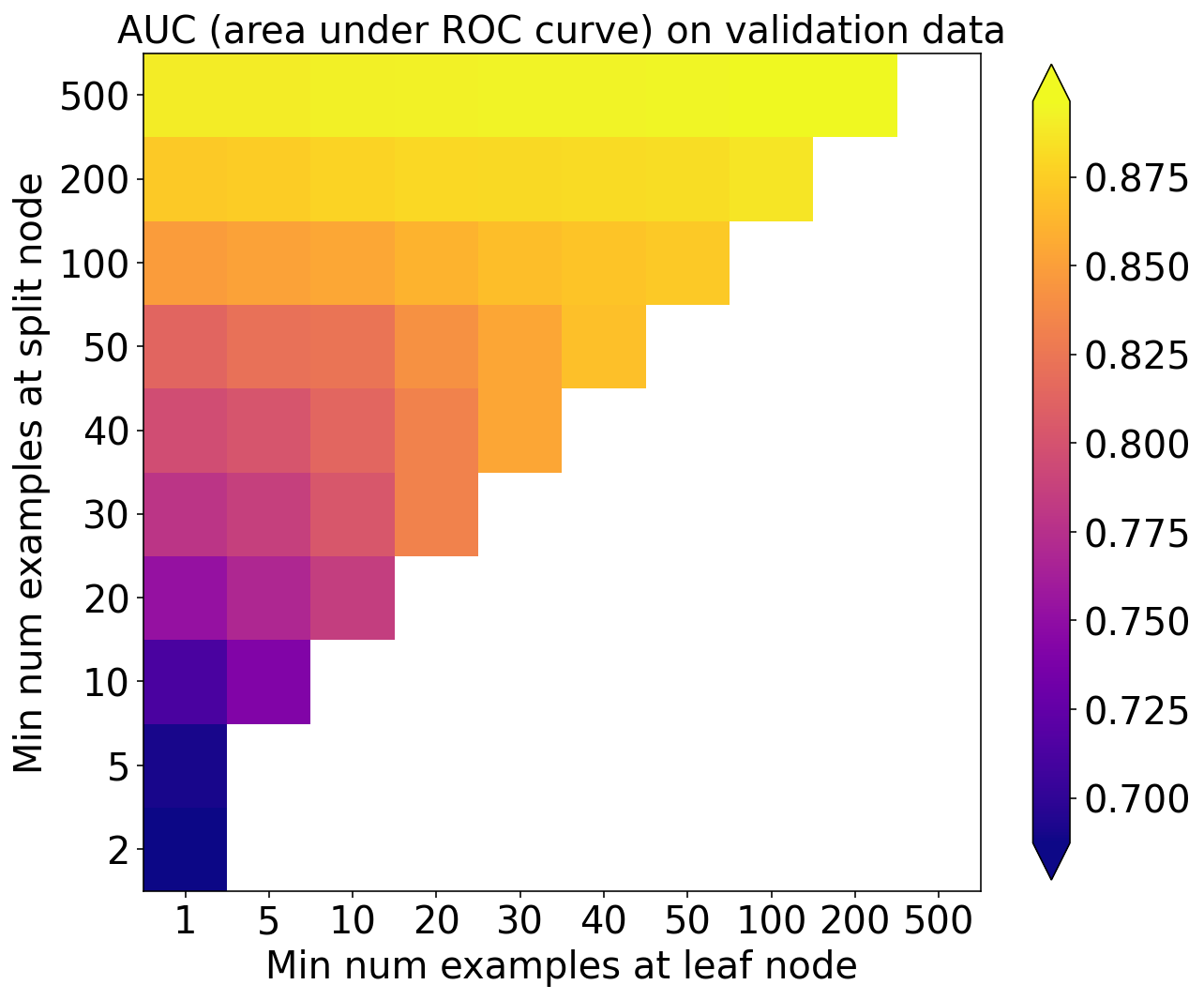
Max CSI
plot_scores_2d(
score_matrix=validation_max_csi_matrix,
min_colour_value=np.nanpercentile(validation_max_csi_matrix, 1.),
max_colour_value=np.nanpercentile(validation_max_csi_matrix, 99.),
x_tick_labels=min_per_leaf_values,
y_tick_labels=min_per_split_values
)
pyplot.xlabel('Min num examples at leaf node')
pyplot.ylabel('Min num examples at split node')
pyplot.title('Max CSI (critical success index) on validation data')
pyplot.show()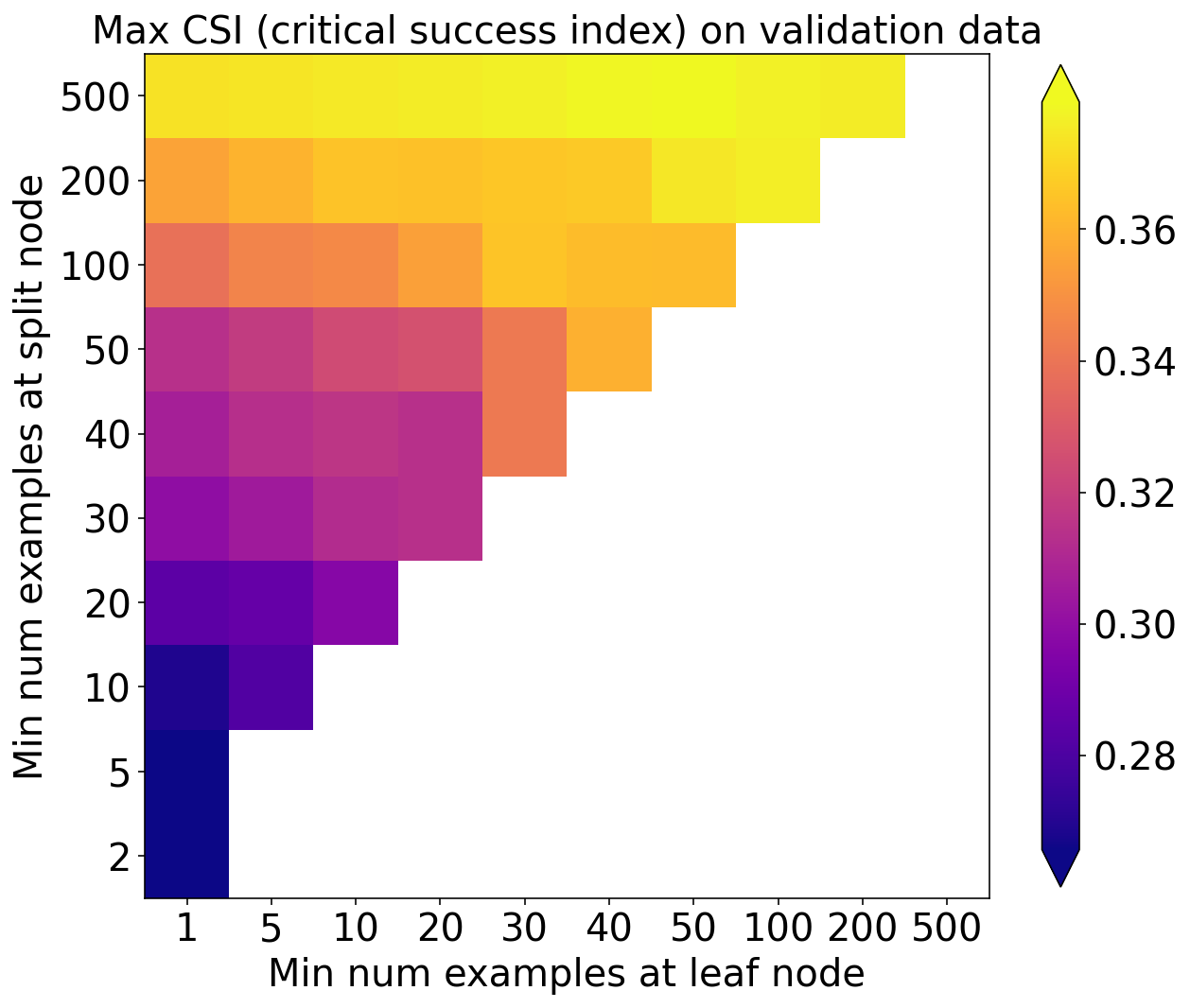
Brier score
plot_scores_2d(
score_matrix=validation_bs_matrix,
min_colour_value=np.nanpercentile(validation_bs_matrix, 1.),
max_colour_value=np.nanpercentile(validation_bs_matrix, 99.),
x_tick_labels=min_per_leaf_values,
y_tick_labels=min_per_split_values
)
pyplot.xlabel('Min num examples at leaf node')
pyplot.ylabel('Min num examples at split node')
pyplot.title('Brier score on validation data')
pyplot.show()
Brier skill score
plot_scores_2d(
score_matrix=validation_bss_matrix,
min_colour_value=np.nanpercentile(validation_bss_matrix, 1.),
max_colour_value=np.nanpercentile(validation_bss_matrix, 99.),
x_tick_labels=min_per_leaf_values,
y_tick_labels=min_per_split_values
)
pyplot.xlabel('Min num examples at leaf node')
pyplot.ylabel('Min num examples at split node')
pyplot.title('Brier skill score on validation data')
pyplot.show()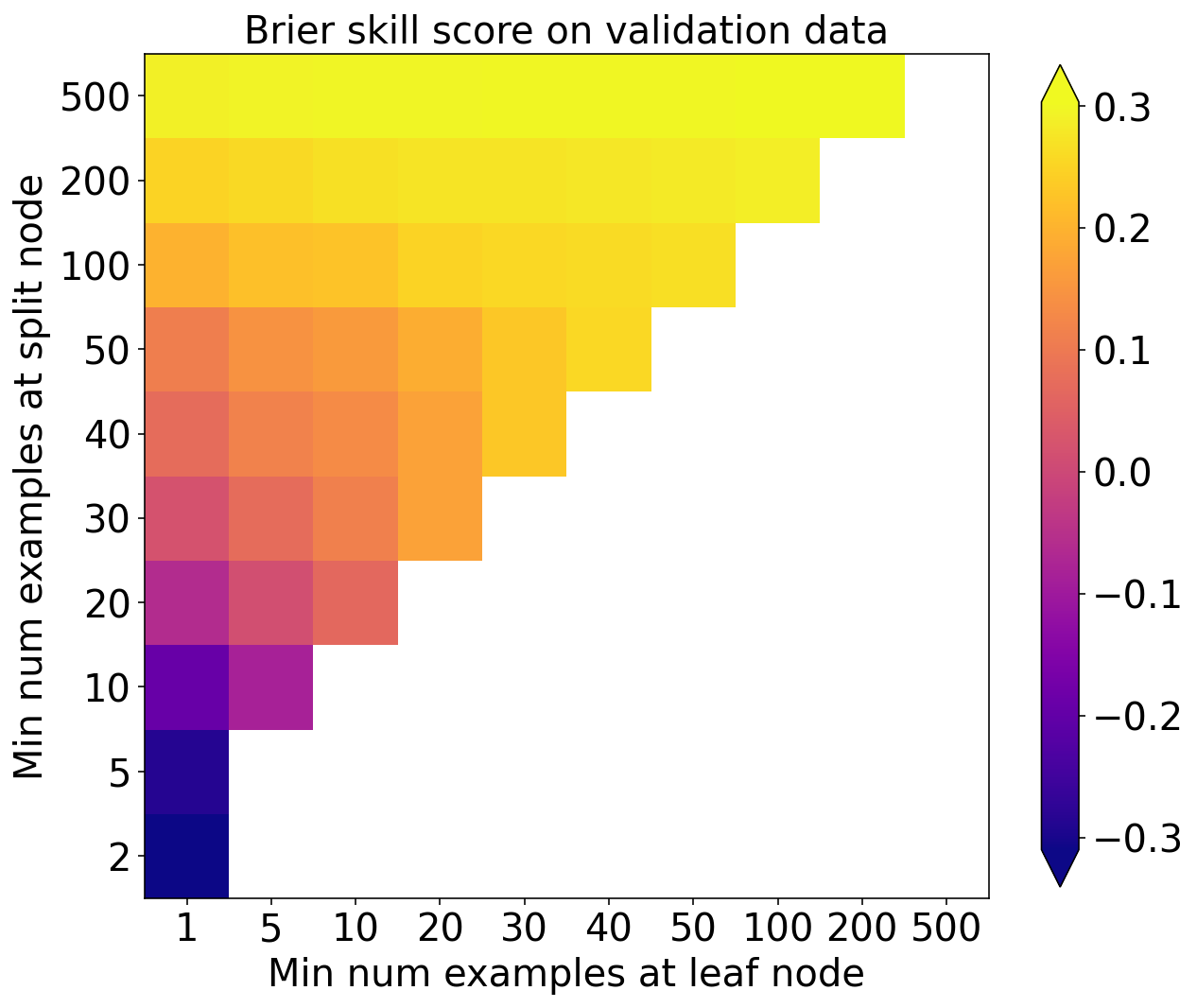
选择
下一个单元格执行超参数实验的第 4 步(选择模型)。
选择 BSS 最大的模型作为最佳模型
best_linear_index = np.nanargmax(np.ravel(validation_bss_matrix))
best_split_index, best_leaf_index = np.unravel_index(
best_linear_index,
validation_bss_matrix.shape
)
best_min_examples_per_split = min_per_split_values[best_split_index]
best_min_examples_per_leaf = min_per_leaf_values[best_leaf_index]
best_validation_bss = np.nanmax(validation_bss_matrix)
print(
f'Best validation BSS = {best_validation_bss:.3f}\n'
f'corresponding min examples per split node = {best_min_examples_per_split}\n'
f'min examples per leaf node = {best_min_examples_per_leaf}'
)Best validation BSS = 0.304
corresponding min examples per split node = 500
min examples per leaf node = 200
使用超参数构建并训练模型
final_model = setup_classification_tree(
min_examples_at_split=best_min_examples_per_split,
min_examples_at_leaf=best_min_examples_per_leaf
)
_ = train_classification_tree(
model=final_model,
training_predictor_table=training_predictor_table,
training_target_table=training_target_table
)在测试集上预测
testing_predictions = final_model.predict_proba(
testing_predictor_table.values
)[:, 1]
training_event_frequency = np.mean(
training_target_table[BINARIZED_TARGET_NAME].values
)评估在测试集上的性能
_ = eval_binary_classifn(
observed_labels=testing_target_table[BINARIZED_TARGET_NAME].values,
forecast_probabilities=testing_predictions,
training_event_frequency=training_event_frequency,
create_plots=True,
verbose=True,
dataset_name='testing'
)Testing Max Peirce score (POD - POFD) = 0.657
Testing AUC (area under ROC curve) = 0.900
Testing Max CSI (critical success index) = 0.423
Testing Brier score = 0.053
Testing Brier skill score (improvement over climatology) = 0.412
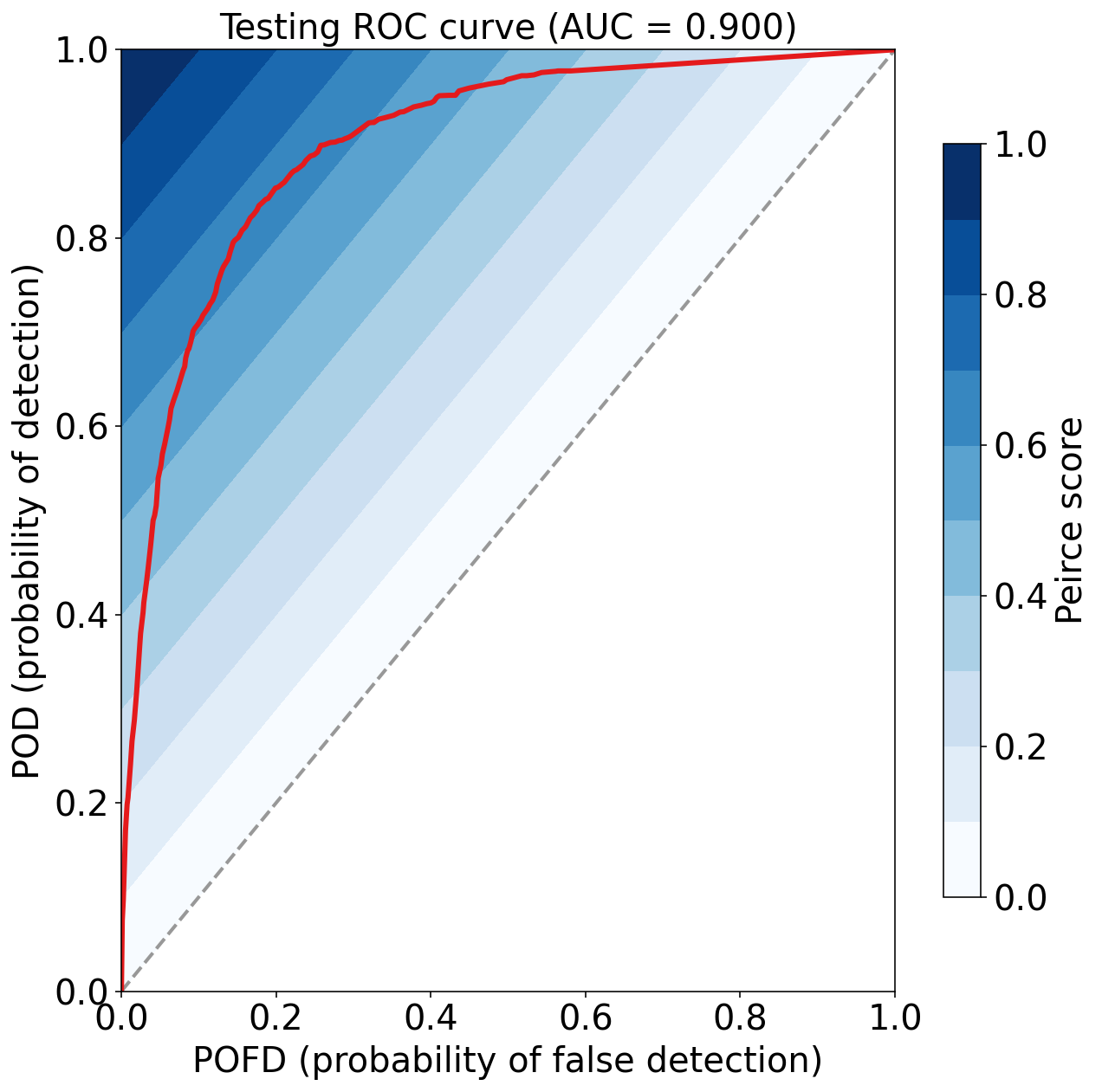
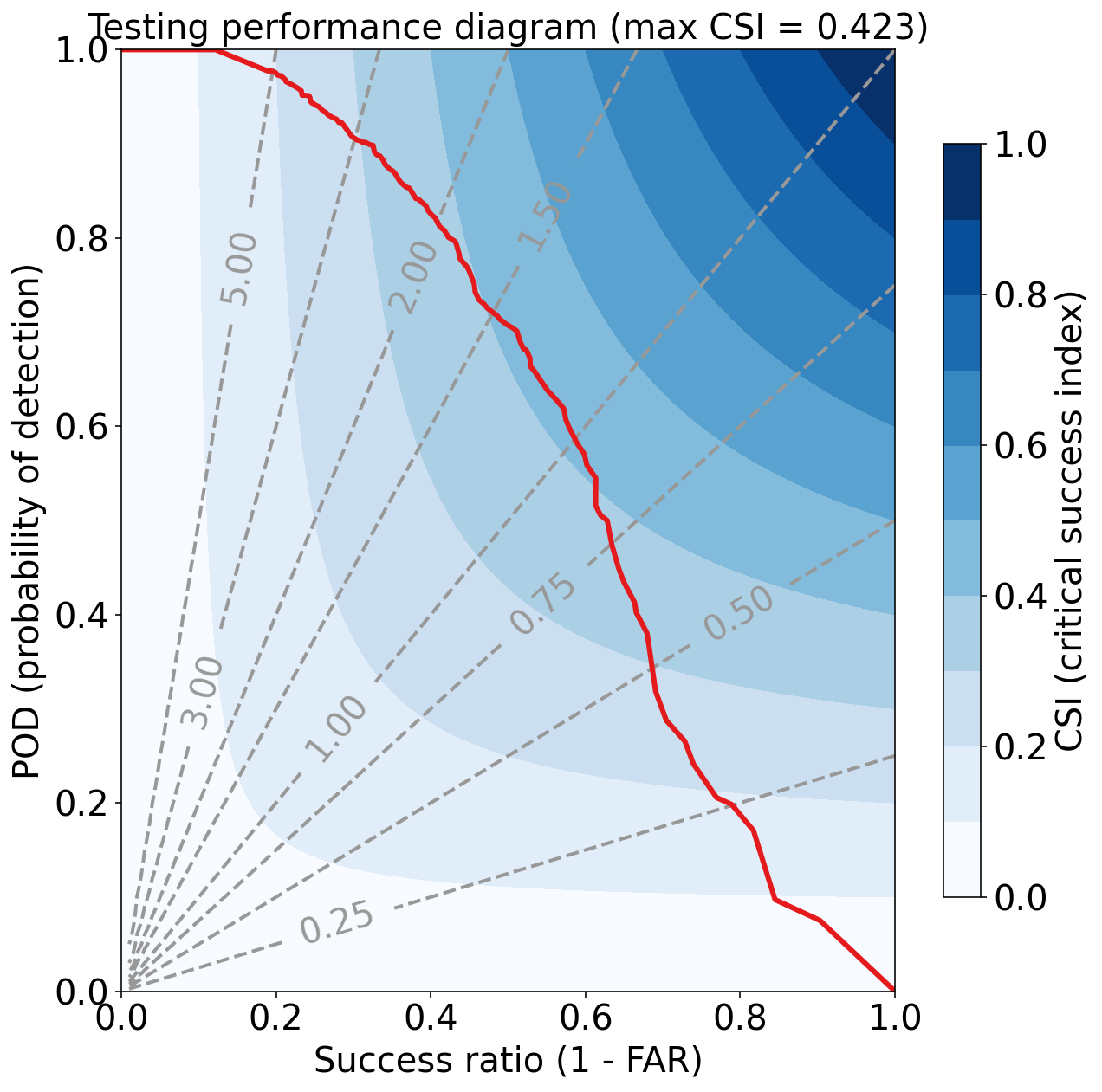
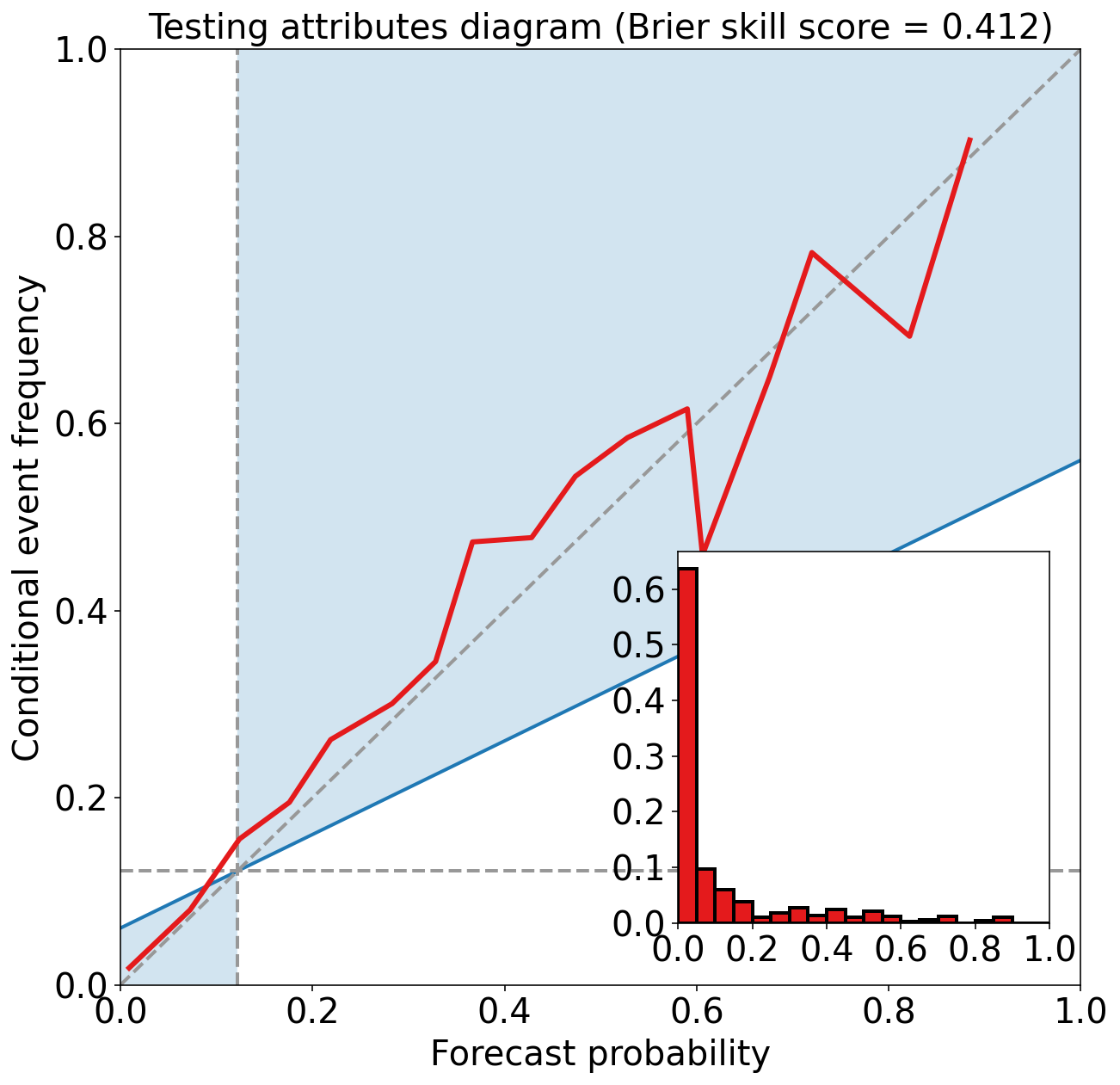
练习
基于第一个超参数实验,编写自己的超参数实验(使用不同的 N_{b}^{min} 和 N_{l}^{min} 集合)。 查看是否可以找到在验证数据上更有效的组合。 如果找到在验证数据上更有效的组合,请查看它在测试数据上是否也更好。 如果不是,则 N_{b}^{min} 和 N_{l}^{min} 在验证集上过拟合 。
参考
https://github.com/djgagne/ams-ml-python-course
AMS 机器学习课程
数据预处理:
《数据分析与预处理》
实际数据处理:
线性回归:
逻辑回归:
决策树:
